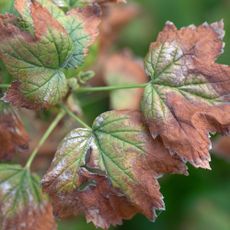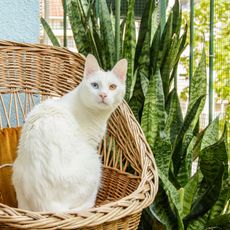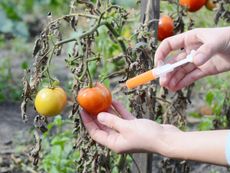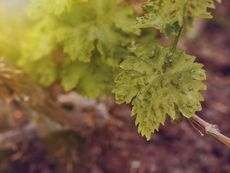Blight Treatment - Symptoms And Control Of Southern Blight On Plants


It happens to the best of us. Your garden grows so nice and then, without any warning, you turn around and notice all your healthy plants wilting and dying. Southern blight on plants is a common problem in many home gardens but it doesn't have to be. How do you control southern blight before it takes out all of your plants? Keep reading to find out ways for controlling southern blight in gardens.
What is Southern Blight?
Southern blight, southern wilt, southern stem rot, and southern root rot all refer to the same disease. It is caused by the soil borne fungus Sclerotium rolfsii. The disease attacks a wide range of vegetable crops and ornamental plants at or below the soil line. Southern blight on plants is most likely to occur in the summer months when the soil is warm and moist. Symptoms include discolored lower leaves, wilted foliage, and plant collapse and it usually results in the death of the plant. Upon close inspection, you may find an abundance of white hyphae or mycelia around the lower stem and roots and in the surrounding soil. When you find the hyphae or mycelia, the best course of action is to dispose of the plant and the soil surrounding it.
How Do You Control Southern Blight?
Controlling southern blight in the home garden is a challenge because the fungicides that are effective in treating the disease are only available to commercial growers. Home gardeners must depend on cultural practices to control the disease. In the home garden, southern blight treatment begins with good sanitation to prevent the spread of the disease. The disease organism travels around the garden in bits of soil that clings to garden tools and the soles of shoes. Remove the soil before moving from one part of the garden to another. Quarantine new plants by growing them in a bed that is isolated from the rest of the garden until you are sure they are disease-free. Remove and destroy diseased plants, along with the surrounding soil and any garden debris or mulch that has come in contact with them. Don't transplant any nearby plants to other parts of the garden. Soil solarization is an effective method of killing the fungus in the south, but in northern climates, the soil temperatures may not be high enough to eradicate the disease. Cover the soil with a clear plastic tarp and leave it in place while the heat builds up under it. The top two inches (5 cm.) of soil must come to a temperature of at least 122 degrees F. (50 C.) to kill the fungus. If all else fails, consider calling in a landscape professional to treat your garden soil with the appropriate fungicides specified for southern blight treatment.
Gardening tips, videos, info and more delivered right to your inbox!
Sign up for the Gardening Know How newsletter today and receive a free download of our DIY eBook "Bring Your Garden Indoors: 13 DIY Projects For Fall And Winter".

Jackie Carroll has written over 500 articles for Gardening Know How on a wide range of topics.
- Amy DraissDigital Community Manager
-
 Do You Know The Most Common Garden Plant Diseases? 5 Problems You Need To Avoid
Do You Know The Most Common Garden Plant Diseases? 5 Problems You Need To AvoidDon’t let your precious crops and ornamentals fall victim to garden ailments! We show you how to identify and hopefully prevent 5 common garden plant diseases
By Tonya Barnett
-
 Are Snake Plants Toxic To Cats? Here’s How To Protect Your Felines And Avoid Trouble
Are Snake Plants Toxic To Cats? Here’s How To Protect Your Felines And Avoid TroubleAre snake plants toxic to cats? A good rule of thumb is to simply keep the plant where kitty can’t get to it.
By Mary Ellen Ellis
-
 Verticillium Wilt Treatment: What Is Verticillium Wilt And How To Fix It
Verticillium Wilt Treatment: What Is Verticillium Wilt And How To Fix ItLeaves that curl, wilt, discolor and die may mean that a plant is suffering from verticillium wilt. Read here to find out how to distinguish verticillium wilt from other plant diseases and what to do about it.
By Jackie Carroll
-
 Fusarium Wilt Disease: Tips For Controlling Fusarium Wilt On Plants
Fusarium Wilt Disease: Tips For Controlling Fusarium Wilt On PlantsThere is a fungus among us and its name is Fusarium. Fusarium fungus can survive indefinitely, affecting any crop or plant that is contaminated by the soil. Find out how to protect and treat your plants in this article.
By Bonnie L. Grant
-
 Anthracnose: How To Identify, Prevent, And Treat The Fungal Disease
Anthracnose: How To Identify, Prevent, And Treat The Fungal DiseaseIdentifying it is the first step toward anthracnose treatment. Treating those nasty spots with fungicide, proper irrigation, and garden cleanup can help.
By Teo Spengler